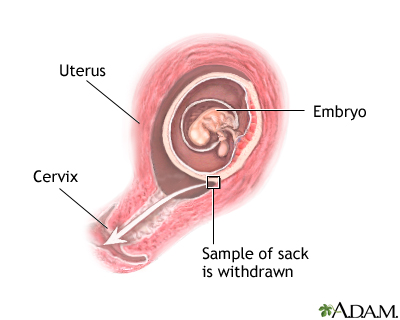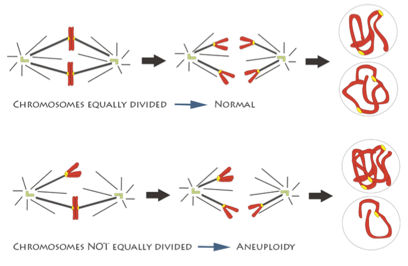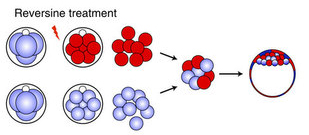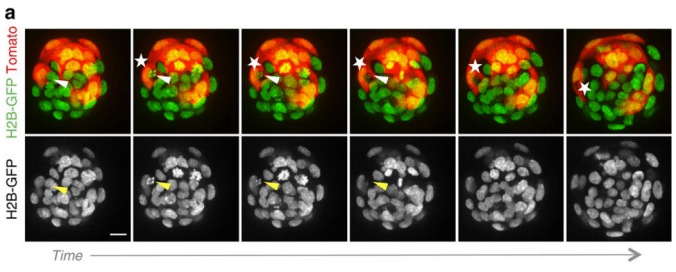
In a chorionic villus sampling (CVS) test, cells from the fetal side of the placenta are collected and tests for genetic defects.
Image credit: ADAM Health Solutions
Like an increasing number of women, Magdalena Zernicka-Goetz waited later in life to have kids and was pregnant at 44 with her second child. Because older moms have an increased risk of giving birth to children with genetic disorders, Zernicka-Goetz opted to have an early genetic screening test about 12 weeks into her pregnancy. The test, which looks for irregular amounts of chromosomes in the cells taken from the placenta, showed that a quarter of the cells in the developing fetus had genetic abnormalities.
Expectant mothers and tough choices
If she carried the child to term, would the baby have a birth defect? Zernicka-Goetz learned from geneticists that this question was difficult to answer due to a lack of data about what happens to abnormal cells in the developing fetus. Fortunately, her baby was born happy and healthy. But the experience motivated her to seek out a better understanding for the sake of other women who would be faced with similar difficult decisions based on screening tests.
As a professor of developmental biology at Cambridge University, Zernicka-Geotz had the expertise to follow through on this challenge. And in a Nature Communications journal article published yesterday, she and her team report a fascinating result: the very early embryo has the ability to essentially repair itself by getting rid of abnormal cells.
Aneuploidy: You Have the Wrong Number

Aneuploidy in the developing fetus can lead to genetic disorders. Image credit: Deluca Lab Colorado State University
To reach this finding, the team first had to recreate chromosomal abnormalities in mouse embryos. If you remember your high school or college biology, you’ll recall that before a cell divides, it duplicates each chromosome and then each resulting “daughter” cell grabs one chromosome copy using a retracting spindle fiber structure. The scientists took advantage of the fact that treating dividing cells with the drug reversine destabilizes the spindle fibers and in turn causes an unequal divvying up of the chromosomes between the daughter cells. In scientific jargon the condition is called aneuploidy.
Rescuing the embryo by cellular suicide

Generating early mouse embryos with an equal mix of normal cells and cells with abnormal chromosome numbers (induced via reversine treatment). Image credit: Bolton et al. Nat Commun. 2016 Mar 29;7:11165
The researchers created mosaic embryos at the eight cell stage in which half the cells had a normal set of chromosomes while the other half we’re the reversine-treated cells with abnormal numbers of chromosomes. With these genetically mosaic embryos, the team tagged the cells with fluorescent dye and used time-lapsed imaging to track the fate of each cell for 48 hours. They found a decrease specifically in the portion of cells that stemmed from the abnormal cells.
A follow up experiment examined cell death as a way to help explain the reduced number of abnormal cells. The researchers found that compared to the normal set of cells in the embryo, the abnormal cells had a significantly higher evidence of apoptosis, or programmed cell death, a natural process that occurs to eliminate harmful or damaged cells. According to Zernicka-Geota and the team, this is the first study to directly show the elimination of abnormal cells in the growing embryo.

Time lapse images showing an abnormal cell (green cell indicated by arrow) being eliminated by apoptosis (programmed cell death) and then engulfed by normal (red) cells (engulfment indicated by star).
Image credit: Bolton et al. Nat Commun. 2016 Mar 29;7:11165
To look at their fate beyond the very early stages of development, the mosaic mouse embryos were implanted into foster mothers and allowed to develop to full term. Thirteen of the twenty-six embryos transferred to foster mothers gave rise to live pups which were all healthy after four months of age.
As Zermicka-Geota stated in a university press release picked up by Medical Express, if these findings reflect what goes on in human development, then decisions based on genetic screening results may not be clear cut:
“We found that even when half of the cells in the early stage embryo are abnormal, the embryo can fully repair itself. It will mean that even when early indications suggest a child might have a birth defect because there are some, but importantly not all abnormal cells in its embryonic body, this isn’t necessarily the case.”
Implications for genetic testing on days-old IVF embryos
These new results don’t suggest that current genetic testing is obsolete. For instance, the amniocentesis test, which collects fetal tissue from the mother’s amniotic fluid between 14 and 20 weeks of pregnancy, can detect genetic disorders with 98-99% accuracy. But this study may have important implications for testing done much earlier. When couples conceive via in vitro fertilization, a so-called pre-implantation genetic diagnosis (PGD) test can be performed on embryos that are only a few days old. In the test, a single cell is removed – without damaging the embryo – and the cell is tested for chromosomal defects. Based on this study, a positive PGD test may be misleading if that abnormal cell was destined to be eliminated from the embryo.

My son has a mutated gene in the fifth chromosome. He started having brain siezures at ten years of age. I had his dna tested at prespatarian Hospital in ny they told me the mutation happened denovo. My question is can the mutation be repaired? He is twenty six now and reads writes operates computers games He shops on Amazon for the best price of the games he wants. This is years of hard work. He takes keppra and hasn’t had a seizure in years. Yet he can’t cut a steak. He has no muscle tone at all. Can cells be implanted into the chromosome to aid in the function of the chromosome.
Thanks
Eileen
Hi Eileen, thanks for the email and I’m so sorry to hear about your son. That must be incredibly challenging and frustrating for him and the whole family. I’m afraid I don’t know of any treatment that might help your son. It’s possible that there are researchers working on a treatment like this but I haven’t heard of it. I am sorry I don’t have better news for you but wish you and your son all the best.
Yours
Kevin